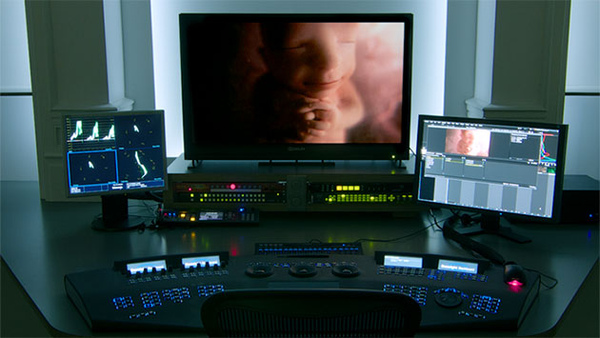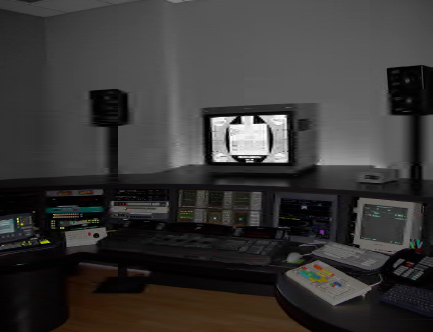|

Post facility with Dolby reference monitor
Introduction:
The technique of video bias lighting has been in use for decades by professionals and consumers who understand what is required for optimum picture quality and viewing comfort when using electronic displays.
Video programs are mastered on calibrated professional monitors in "dim surround" conditions. It has long been understood that the best viewing condition for television programs is in a darkened environment. Total darkness is not recommended due to the limitations of the human visual system. Televisions and similar electronic displays are much brighter than large format front projection movie screens, which don't require supplemental illumination in the room.
What are the recommended elements of properly implemented bias lighting?
1. The color of light should be as close as possible to the video white point of 'CIE D65' (loosely referred to as 6500 Kelvins) for color video viewing ['D50,' the 'E' point, or ~5400K in other specific applications].
2. The color rendering index (CRI) is often published for a given lamp. A minimum CRI of 90 out of 100 is recommended for color reference applications.
3. The illumination should originate from behind the frontal plane of the screen to avoid reflections, haze, and glare (which interfere with, contaminate, and obscure the image).
4. The lamp itself should not be directly visible to the viewer, but rather the illumination should be reflected by surrounding surfaces, such as the wall behind the monitor.
5. The brightness of the reflected illumination should be 10% or less of the brightest white the monitor is adjusted to (calibrated for a dark environment).
6. Surrounding surfaces within the observer's field of view of the monitor screen should be neutral in color (gray to white), see: Munsell Color Order System's neutral value scale.
7. Completely surrounding the monitor screen with illumination is not necessary to realize the principle benefits of the technique.
8. It usually works best for the lamp to be mounted on the back of the monitor or TV cabinet (rather than on the wall), in order for the illumination to spread out over some distance.
9. Test patterns for adjusting bias lighting relative to the monitor screen are available in many optical disc programs for setting up home entertainment systems (see: 'Avia II- Guide to Home Theater,' 'Digital Video Essentials' series, etc.).
What are the proven benefits of correctly implemented bias lighting?
1. Reduces or eliminates eye strain and viewing fatigue in dark viewing conditions.
2. Eliminates image contamination due to reflections, haze and glare on the screen from conventional room lighting.
3. Enhances perceived black levels, contrast ratio, and picture detail by enabling dark adapted viewing.
4. Preserves correct color perception of the video image by the viewer.
5. Prolongs monitor phosphor life by enabling dark room viewing and lowering of screen brightness requirements (phosphors are used in CRTs, plasmas, and LCDs with CCF or white LED back lighting).
6. Provides a low level of illumination in the room for movement and peripheral activities.
Says who?
The following organizations are confirmed to define, recommend, specify, and/or use the technique of video bias lighting:
The Society of Motion Picture and Television Engineers (SMPTE)
The International Organization for Standardization (ISO)
The International Telecommunications Union (ITU)
The National Institute of Standards and Technology (NIST)
The Metropolitan Museum of Art
Industrial Light and Magic (ILM)
The Imaging Science Foundation (ISF)
THX, Ltd.
Electronic Arts (EA)
Deluxe
Microsoft Corporation
Image Entertainment
Universal Studios
PostWorks
Joe Kane Productions
Ovation Multimedia
DisplayMate Technologies
CNET Labs
Radical Games
Factor5 Studios
High Moon Studios
CinRam
Rev13 Films
Advanced Television Evaluation Lab- Communications Research Centre- Canada
Apple Corporation
Filet Post Production
Post and Beam |
Cheyenne Mtn. Entertainment
Zombie Studios
CBS Television
Deluxe Digital Studios
Splice Here
Slant Six Games
New Hat LLC
Roush Media
Samsung Germany
Digital Film Lab- Denmark
Nice Shoes, VFX New York
Desperate Housewives, Editorial
Rockhopper Post
Live Nation Studios
LionAV Consultants
Avical
Technicolor-NY
Technicolor-Canada
Max Post
Bandito Brothers Studio
Chainsaw Edit
Twin Cities Public Television
Colorflow Post
ABC Television
The Moving Picture Company
Dolby Labs
Dreamworks Animation
Univ. of Quebec at Montreal
No6 |
Technical references for more detailed explanations of bias lighting:
SMPTE Recommended Practices document: RP166-1995: ‘Critical Viewing Conditions For Evaluation Of Color Television Pictures’
ITU-R BT.710-4 'Subjective Assessment Methods For Image Quality In High-Definition Television'
ISO 17121:2000: 'Cinematography -- Work stations used for film and video production -- Requirements for visual and audio conditions'
'The Importance of Viewing Environment Conditions in a Reference Display System' G. Alan Brown, https://cinemaquestinc.com/ive.htm
'Digital Video Essentials: HD Basics' Blu-ray Disc program, by Joe Kane Productions
'Tips on Buying a New Flat Panel Display' NIST Flat Panel Display Laboratory, http://www.fpdl.nist.gov/Tips.pdf [includes graphic demonstrations of screen reflection issues]
Graphic depictions of ambient lightness enhancing perceived black and contrast: https://www.youtube.com/watch?v=xl1lL...eature=channel ; https://www.youtube.com/watch?v=rFmgSP97fTg ; https://www.youtube.com/watch?v=kdOQBPCOk5w&NR=1 ; https://www.youtube.com/watch?v=MMJ6t...eature=channel
Pertinent technical quotes:
"Monitor white reference: In additive mixture, the illumination of the reproduced image is generated entirely by the display device. In particular, reproduced white is determined by the characteristics of the display, and is not dependent on the environment in which the display is viewed. In a completely dark viewing environment, such as a cinema theater, this is desirable; a wide range of chromaticities is accepted as “white.” However, in an environment where the viewer’s field of view encompasses objects other than the display, the viewer’s notion of “white” is likely to be influenced or even dominated by what he or she perceives as “white” in the ambient. To avoid subjective mismatches, the chromaticity of white reproduced by the display and the chromaticity of white in the ambient should be reasonably close." from Charles A. Poynton's, 'Digital Video and HDTV Algorithms and Interfaces'
"Contrast could be considered to be the most significant quality that impacts not only the perceived depth of an image, but also affects the apparent sharpness.....While the luminance level of a given image affects how the eye perceives contrast and detail, the ambient conditions surrounding the image can also have a dramatic impact. This phenomena was studied by Bartleson and Breneman (1967) to examine the impact of perceived contrast based not only on the luminance level of the image but taking into account the surrounding ambient luminance levels as well. Their results showed that the perceived contrast increased as ambient luminance increased. With the increase in ambient luminance, the eye interprets black levels as being darker while the impact to the white level is minimal. Since the perceived difference in dark areas is greater under the higher ambient luminance conditions, the perceived contrast is higher. It is a natural tendency to want low ambient luminance levels to strive for "better" perceived image quality and what is thought to result in higher contrast. However, in reality, the opposite is true. This tendency may be justified for current direct view CRT televisions due to the issue of glare that results from the glossy surface of the glass tube [also true for certain flat panel displays today]. With less ambient luminance, the glare is reduced- but it may be important to keep some ambient luminance behind the television [as in the case of bias lighting] to keep the perceived contrast higher.....While sharpness can affect the apparent contrast of an image, the converse is true in that contrast can also impact the apparent sharpness of an image. Images that have lower contrast will appear to be not as sharp as an image of the same content, but with higher contrast.....A subjective study was then conducted to verify the impact that ambient lighting has on perceived contrast. Several non-technical (and thus presumably non-biased) and technical observers were asked to compare a series of images with various ALL [average luminance levels] under different ambient luminance extremes in order to understand the impact that ambient viewing conditions might have on the perceived contrast between the two television technologies [CRT and DMD (DLP RPTV)]. Under dark ambient conditions, the result for images with an ALL > 5% was found to be equal between the CRT and the first DMD display. However, under bright ambient conditions (about 250 nits of luminance on the wall behind all of the units), the DMD display was favored over the CRT by 50% of the observers as having higher perceived contrast.....This proved that ambient conditions have the effect of potentially raising the black level threshold of the eye above the actual black level of the television such that the perceived contrast ratio is higher." from the SMPTE Journal, 11/02. 'The Importance of Contrast and its Effect on Image Quality' by Segler, Pettitt and Kessel
"Their experimental results, obtained through matching and scaling experiments, showed that the perceived contrast of images increased when the image surround was changed from dark to dim to light. This effect occurs because the dark surround of an image causes dark areas to appear lighter while having little effect on light areas (white areas still appear white despite changes in surround). Thus since there is more of a perceived change in the dark areas of an image than in the light areas, there is a resultant change in perceived contrast.....Often, when working at a computer workstation, users turn off the room lights in order to make the CRT display appear of higher contrast. This produces a darker surround that should perceptually lower the contrast of the display. The predictions of Bartleson and Breneman are counter to everyday experience in this situation. The reason for this is that the room lights are usually introducing a significant amount of reflection off the face of the monitor and thus reducing the physical contrast of the displayed images. If the surround of the display can be illuminated without introducing reflection off the face of the display (e.g., by placing a light source behind the monitor that illuminates the surrounding area), the perceived contrast of the display will actually be higher than when it is viewed in a completely darkened room." from 'Color Appearance Models,' by Mark D. Fairchild, Ph.D., of the Chester F. Carlson Center for Imaging Science: Munsell Color Science Laboratory

|

